#Blood Sweat & Tears fan theory
Text
We’re not a blog that is dedicated to reviewing music (including Kpop), but because we absolutely adore BTS and their music, we decided to do a memo-style review of the Music Video (MV) for their Japanese Version “Blood, Sweat & Tears” (血、汗、涙 -Japanese Ver.-).
***Note: If this is your first time browsing the Drama Files, please read The Rules on how our Memo-style reviews work.***
***Note: We really wanted to analyze the Blood, Sweat, Tears Korean MV before, but we missed out on the opportunity. We thought this MV was very interesting as well, so we were really eager to share our theories about what they could possibly signify. There are definitely many theories, so we thought we’d propose ours. Our views are simply theories and purely speculative.***
Memo
Dear Reader,
There have been some questions regarding the recent release of BTS’s 血、汗、涙 -Japanese Ver.- (“BST”), particularly:
(1) Who/What does each member represent?
(2) How is the ending clip that is reminiscient of the “I Need U” MV connected to BST?
Conclusion
(1.1) J-Hope acts as a guide. J-Hope is Archangel Michael and Frau Eva from Demian.
(1.2) V is Max Demian (“Demian”) from Demian and the Devil/Lucifer/the Fallen Angel (“the Devil”).
(1.3) Suga is Pistorius and the Old Wise Man (archetype).
(2) This will be answered in a subsequent Memo.
Background
Please read the first post to understand how this MV fits in with the other MVs and the different types of reality in this MV.
Please read the second post for a background on Demian and other important concepts.
Here is some background information about Pistorius. In Demian, Pistorius is an organist whom Sinclair meets after his rebellious phase in boarding school. Sinclair also meets Pistorius after discovering a note in one of his books and the note talks about Abraxas. During one of his walks, he hears some unorthodox organ music and then meets Pistorius. Pistorius is the son of a well-respected clergyman and is a theologian as well. Pistorius sees mythology and religion as being connected, which made him inappropriate to act as a clergyman. Pistorius ends up becoming Sinclair’s mentor and teaches him in his room, before a fireplace. Although Pistorius shares interests in Abraxas and teaches Sinclair many concepts, Pistorius still chooses to accept/stay with the traditional view of Christianity.
Analysis
(1.1) J-Hope acts as a guide. J-Hope is Archangel Michael and Frau Eva from Demian.
Please read the first post to see this analysis.
(1.2) V is Max Demian (“Demian”) from Demian and the Devil/Lucifer/the Fallen Angel (“the Devil”) .
Please read this post for more information on V.
(1.3) Suga is Pistorius and the Wise Old Man (archetype).
Jubiemon J: We will first look at Suga’s character based on an analysis of Pistorius in Demian and then we will see how he fits in with one of the Jungian archetypes.
(i) Suga is Pistorius due to his connection with the piano/organ, his pairings with Jungkook and Jimin, and his short clip “First Love”.
First, in both “BST” MVs, Suga is always associated with a piano or organ. (Side note: I know in the MVs, pianos are used instead, probably because of an ease of transportation. However, in the Korean “BST” MV, we hear Suga playing the organ during one of the MV breaks. That’s why I say “piano or organ”.) Likewise, Pistorius is . . . an organist!

Suga the pianist in the Korean “BST” MV!
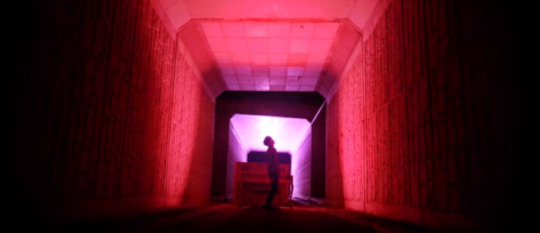
Suga in “BST” with the piano behind him!
Secondly, Suga has a mentor/mentee relationship with two of the members, Jimin and Jungkook.
This relationship works because of a couple of assumptions:
(a) A character’s identity based on Demian changes depending on the member’s relationship to another and that at some point, everyone starts out as a Sinclair. The only character that is fixed is J-Hope’s (See Figure 1: Chart of Relationships below.)
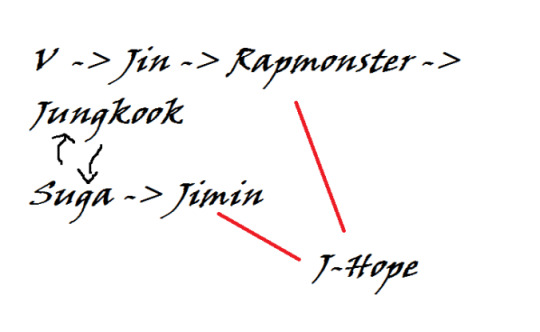
Figure 1: Chart of Relationships
(b) For the Korean “BST”, ““I Need U”, “Run”, and BTS 화양연화 On Stage Prologue, there are different timelines going on.
There will be a memo giving a summary of all the relationships. For now, we will just focus on the Suga/Jungkook and Suga/Jimin pairings as this post is about Suga. The arrow means “influences”. The red line means “connects”. J-Hope connects to everyone. Suga influences Jimin. Jungkook influences Suga and Suga also influences Jungkook.
Suga/Jungkook pairing
In the MVs for “BST” and “Run” and the short clip/teaser for Jungkook’s “Begin”, we see Jungkook and Suga being grouped as a duo. Jungkook is Sinclair and Suga is Pistorius.
In Jungkook’s “Begin” clip, Jungkook holds a drawing of Suga and there is also a drawing of Suga on the wall. We then see a painting in front of Jungkook. It’s hard to tell who that painting is of; it could be Suga, V, or Jungkook. (This will be explained in detail in Jungkook’s post.) In the chapter, Jacob’s Fight with an Angel, which is where Pistorius is introduced, Sinclair also looks at a painting that is of a half-male/half-female. The painting then continues to change forms and Sinclair also claims he had burned it. That’s similar to the short clip.
Now that we see that Suga is connected to Jungkook. We will examine their relationship. Suga and Jungkook only interact with each other in the external reality. In “Run”, Suga is the one that seems to want to start something and Jungkook is restraining him. I think that’s more or less symbolic that Jungkook is somewhat resisting change. It’s analogous to the scene in Demian where Pistorius challenges some moral beliefs that Sinclair held. Sinclair believes that murdering someone you hate is still wrong. Pistorius says that if we want to murder someone we hate, it’s because that person possesses something that we hate within ourselves.
Suga is able to dominate Jungkook who is left on the ground, injured. By Suga throwing a chair at the mirror that shows blue roses in a vase, he is breaking what seems to be the “unattainable”/”mystery” and lets Jungkook see more of the truth.
Blue roses don’t exist in nature. Blue flowers are generally rare (See here for more explanation.) Blue roses can mean mystery, the unattainable/impossible, new opportunities, and new possibilities (See here).
Notice how it’s the mirror that’s broken and not the actual vase of roses; that’s an important distinction because mirrors tend to represent identity, self-consciousness, as well as the “oppositional themes of reality and illusion, candor and deception, logic and disorder, narcissism and self-loathing, symmetry and imbalance, and flattery and harsh indifference” (See here). On one hand, we see a better self and the world that we live in, yet we also see our subconscious self. In art, mirrors are associated with self-knowledge and vanity due to the Narcissus myth. Moreover, in Christian art, mirrors mean the purity of the Virgin Mary (Look here). Breaking that mirror is also breaking the traditional sense of “purity” and destroying what we know as ourselves (ie illusion).
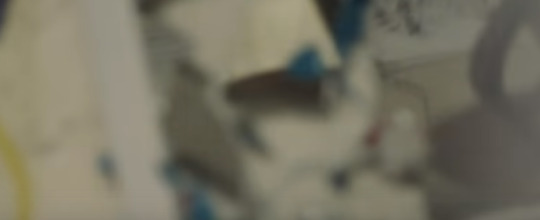
Mirror breaking…not the vase + flowers!
Pistorius also says in the beginning of the chapter to Sinclair: “[Y]ou accuse yourself of taking a road different from most people. You have to unlearn that. Gaze into the fire [. . .] don’t ask whether it’s permitted or would you please your teachers or father, or some god. You will ruin yourself if you do that.” Pistorius is telling Sinclair that Sinclair must break free of what he once believed.
Sinclair eventually says a lot of harsh words to Pistorius like he is antiquated and Sinclair’s friendship with Pistorius comes to an end. Pistorius admits that he still chose to stick with the traditional view of Christianity. Pistorius explains:
I have the desire to become a priest, as you know. I wanted most of all to become the priest of the new religion that we have so many presentiments of. I’ll never be able to–I know that, and I’ve known it for a long time, though I never fully admitted to myself. […] But I must always be surrounded by I feel to be beautiful and holy, organ music and mystery cult, symbol and myth; I need it and I won’t give it up. –That’s my weakness. Because I know at times, Sinclair, I know sometimes that I shouldn’t have such desires, that they represent a luxury and weakness. […] But I can’t (p. 84, Jacob’s Fight with the Angel).
This is like in “BST” where Suga is the one trying to pull Jungkook away from the toilet.
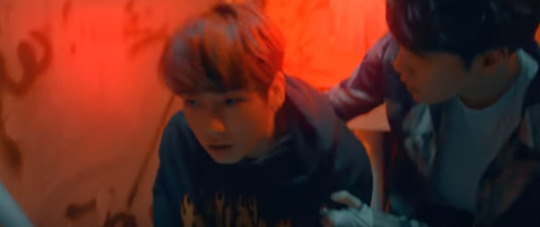
Suga pulling Jungkook away
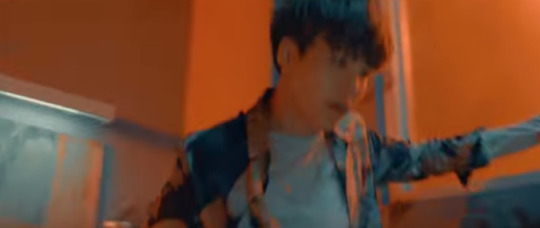
Jungkook pushes Suga away.
Jungkook, in the Korean “BST” MV and in “BST”, ends up succumbing to Rapmonster’s temptation, the absinthe drink. This time it is Jungkook who ironically pushes Suga away and surpasses his mentor. Jungkook is Sinclair and Rapmonster is Demian here. Remember that in the external reality, Suga is still Pistorius to Jungkook, who is also Sinclair.
Suga/Jimin pairing
In the Korean “BST” MV, we only see Suga being paired with Jimin. Suga is the one that’s covering Jimin’s eyes or putting a blindfold on him. Suga is Pistorius and Jimin is Sinclair.

Jimin, as Sinclair, starts out having his eyes covered just by Suga’s hands. He is still not exposed to the harsh reality. Later we move from Rapmonster and Jungkook with the green smoke and up to Jimin and Suga, who are kneeling across from each other. Rapmonster, Demian here, and Jungkook, Sinclair here, are on a level lower than the other two. Pistorius never dives deeper and breaks free from traditional views of the world and Jimin, who is acting as Sinclair here, is at a point where he has just met Pistorius.
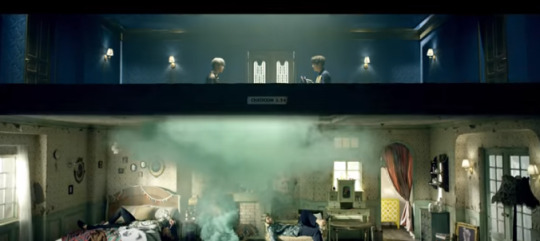
Also notice how Jimin is holding a red apple, while Suga is grasping a black blindfold.

Apple in Jimin’s hand vs black blindfold in Suga’s hands
Blindfolds are important symbols. In Law, Lady Justice wears a blindfold, meaning that a blindfold symbolizes objectivity and impartiality (See here). They can also represent resistance to clarity and mean the interplay between the conscious and the unconscious. Wearing a blindfold symbolises a lesser state of consciousnesses, while taking it off is like an awakening (Source).
The shade black is related to power, authority, death, mystery, evil, rebellion, and strength (Source). In art, the meaning of black changes throughout the periods: in the early Christian period, black was related to evilness, while in the medieval era, it symbolized royalty (Source).

In this case, I think that the black blindfold works to encompass nearly all of the meanings. Jimin is becoming more aware and objective as he wears the blindfold, meaning that he accepts Suga as his mentor. This is like how Sinclair starts to learn from Pistorius. However, by learning from Suga, Jimin is also in a lesser state of consciousness; like mentioned before, Pistorius is still attached to the traditional views of Christianity. There’s power through learning about oneself. There’s a sense of a rebellion from being different from others. There’s also death of one’s old self and mystery in the process of self-discovery. Others might view this change as being evil; hence, Jimin is holding onto that red apple. We know that red apples symbolize the apple from the Garden of Eden. Apples are temptation. Jimin is struggling with temptation here.
Okay, so the question that’s probably lingering in your mind would be this: How can we have two Sinclairs and two Pistoriuses? Remember that we’ve said that the scenes with Jimin, which are filmed in this blue-ish tint, represents the deeper self which is part of the psychical reality.
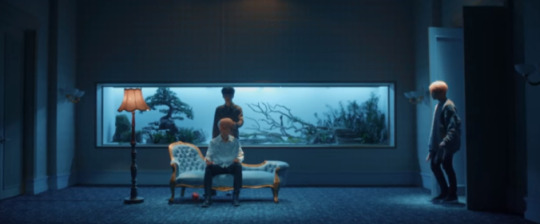
Blue tint!
In fact, Jimin represents all the Sinclairs that are searching for one’s shadow, so you can say that Jimin is an extension of Jungkook, Jin, and Rapmonster.
(Side note: There will be detailed posts about these members later, but for clarity’s sake, a shadow is the unconscious part that we don’t identify with and often associate as the “dark side”.)
If the Pistorius – Sinclair relationship is shown by Suga and Jungkook in the external reality, then that relationship in the inner/psychical reality is depicted by Suga and Jimin.
Finally, Suga is Pistorius because of what’s seen in his short clip: “First Love”. Although it seems like he starts out as Sinclair, he ends up being Pistorius due to his return to his burnt piano. Suga’s MV is positioned at #4 out of the 7 clips. Rapmonster first narrates these lines from the chapter, Beatrice, in Demian.
There are numerous ways in which God can make us lonely and lead us back to ourselves. This is the way he dealt with me at the time.
Beatrice is the chapter that comes before Sinclair meets Pistorius; this is important because it shows that at this point, Suga is kind of like Sinclair. In many ways, Pistorius and Sinclair are quite similar: they are both eccentric and alone and share different views from others. That’s why Rapmonster says those sentences from that chapter where Sinclair has his rebellious stage during boarding school. He goes to bars and gets drunk often.
In the short clip, we see Suga breaking into a store to play the piano until he suddenly stops.
He hears this whistling that attracts him away to the streets that are filled with darkness. A car comes towards him, nearly hitting him. Instead, the car crashes right into the store with the piano. The piano ends up burning. Suga is seen going back to the burning store after he thinks to himself: “Would I have changed? If I had chosen a different path?” (See here. To be honest, I can’t read Korean, so I just have to assume that this translation is accurate. Translation, to me, is an art and you have to be careful about the word you choose to use. In some languages, some words just don’t have the exact meaning in the other language.) Then, Suga watches the burnt piano and stays there.
This whole scene proves that Suga ends up being Pistorius because although he is also attracted to Abraxas like how he follows the whistling and ends up being on that dark street, Suga goes back to the burning piano. We know that the piano/organ is connected to Pistorius. We also know that Pistorius admits that he is not “capable of standing so alone and naked” (Demian). He can’t let go of the past. Suga is running back to what he’s familiar with and what he can’t let go. However, he has already been introduced to the other side and so his piano is burning. He realizes that what he is familiar with isn’t exactly everything that’s meant out to be and that the “New had to be truly new and different”. He recognizes too that he is better served to lead people to self-discovery. The questions too that Suga asks reflect his curiosity about change.
A last point is that in the BTS MVs, Jin is often seen driving a truck, Jungkook is also supposedly hit by a truck in one of the MVs, or the truck carries another member elsewhere. The truck is like a symbol for transporting the members off to somewhere else, to the deeper end. In dreams, a truck is a journey towards one’s goal and is seen as a positive sign (See here). In this case, Suga avoids getting hit by the truck and he also doesn’t fall into a pool of water. The bathtub of water is overflowing, but Suga isn’t in it. Suga is still stuck where he was.
(Side note: In Demian, there’s a lot of symbolism with fire. Pistorius teaches Sinclair concepts in front of a fireplace. Sinclair burns his painting and more. Likewise in the BTS MVs, we will see a lot of symbols related to fire like the cigarette lighter and burning piano.)
(ii) Suga is the Wise Old Man (Archetype).
Jubiemon J: Suga embodies the “knowledge, reflection, insight, wisdom, cleverness and intuition” of the Wise Old Man (Source). When Jimin meets Suga, Jimin learns more about himself. Moreover, Jimin seems to have come to Suga for help in the first place.
Think of the Wise Old Man like Merlin from the legends about King Arthur. In “the phenomenology of the spirit in fairytales” by Carl G Jung, he clarifies that “[t]he figure of the wise old man is observed to appear where insight is needed that the conscious is unable to supply. He continues to explain that in fairytales, the Wise Old Man shows up when the hero is desperate for help and often ask questions to the Hero. Suga also challenges Jungkook in “Run”; we see them fighting with one another. Suga is there when Jungkook is struggling from throwing up in the washroom as seen in “BST”.
(Side Note: The Wise Old Man and Pistorius are thoroughly connected, so this is why this section is shorter.)
(Side Note: I’ve been really enjoying how the short clips have tried their best to integrate not only the meaning of each member’s songs with Demian. Suga’s song, “First Love”, is all about his love for his piano. He raps about how he fell for his piano and then gave it up. Later he returned to loving his piano. I wouldn’t say that Pistorius’ situation is exactly the same as Suga with Pistorius’ feelings towards religion; however, their circumstances are similar.)
As always, feel free to suggest which member you’d like to be analyzed next or to leave comments about your thoughts! Personally, I’m leaning towards analyzing Jimin next as he has been connected to Suga.
Memo: BTS Blood Sweat & Tears (Japanese Version) Music Video Analysis Part 3 We're not a blog that is dedicated to reviewing music (including Kpop), but because we…
#(BTS) WINGS Short Film 4 FIRST LOVE#(BTS) WINGS Short Film 4 FIRST LOVE fan theory#(BTS) WINGS Short Film 4 FIRST LOVE theory#archetypes#Blood Sweat & Tears fan theory#blood sweat & tears theory#blood sweat tears japanese fan theory#Blood Sweat Tears Japanese version analyzed#Blood Sweat Tears Japanese Version MV#blood sweat tears japanese version theory#blood sweat tears mv theory#bts#bts blood sweat tears#bts blood sweat tears japanese mv theory#bts comments#bts demian#bts fan theory#bts first love short film analysis#bts first love short film explained#bts first love suga#bts first love suga short film fan theory#bts first love suga short film theory#bts i need u mv#BTS 피 땀 눈물#bts jimin#bts jungkook#BTS min yoongi#bts mv connections#BTS mv review#BTS MV theories
0 notes